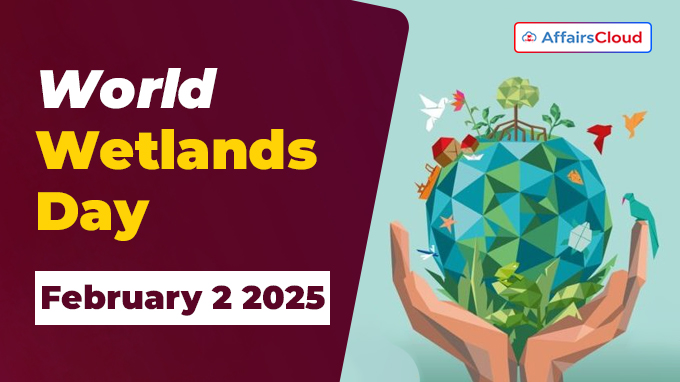 The United Nations (UN’s) World Wetlands Day is observed annually on February 2 across the globe to raise awareness about the critical role wetlands play in supporting both people and the planet.
The United Nations (UN’s) World Wetlands Day is observed annually on February 2 across the globe to raise awareness about the critical role wetlands play in supporting both people and the planet.
- The day commemorates the Convention on Wetlands of International Importance (Ramsar Convention), an intergovernmental treaty signed on 2 February 1971, in Ramsar, Iran along the shores of the Caspian Sea.
Theme 2025:
i.The theme for World Wetlands Day 2025, “Protecting Wetlands for Our Common Future”.
ii.The theme highlights the urgent need to protect wetlands for the benefit of all people for future generations.
Background:
i.The World Wetlands Day observance began in 1997, organized by the Secretariat of the Convention on Wetlands, and has been celebrated by the Convention’s Contracting Parties since its establishment.
ii.On 30 August 2021, the UN General Assembly (UNGA) adopted resolution A/RES/75/317, declaring February 2 as World Wetlands Day every year to halt the loss of wetlands and promote their conservation and restoration.
iii.The first UN-recognized World Wetlands Day was observed on February 2, 2022.
Significance:
i.Every three years, representatives from Contracting Parties meet to discuss wetland conservation and plan the next 3 years.
ii.This year, World Wetlands Day 2025 aligns with the theme of the 15th Meeting of the Conference of the Contracting Parties to the Convention on Wetlands (COP15).
- COP15 will be held in Victoria Falls, Zimbabwe, from July 23-31, 2025.
What are Wetlands?
i.Wetlands are diverse ecosystems where water plays a crucial role in shaping the environment and supporting plant and animal life.
ii.These areas, including freshwater, coastal, and human-made wetlands, offer essential benefits like climate regulation, flood control, and water purification.
Keyfacts:
i.Currently wetlands cover only around 6% of the Earth’s land surface, 40% of all plant and animal species live or breed in wetlands.
- Wetlands are disappearing three times faster than forests and are Earth’s most threatened ecosystem. In just 50 years. Since 1970 ,35% of the world’s wetlands have been lost.
ii.As of February 2025, there are 2,529 Ramsar sites in the World.
- These sites are located in 172 countries that are part of the Ramsar Convention on Wetlands.
- The Cobourg Peninsula in Australia was designated as the world’s first Ramsar Site in 1974.
iii.As of February 2025, India is home to 89 Ramsar sites, the highest number in South Asia in wetland conservation which covers around 1.35 million hectares (h) of land for a Sustainable Ecosystem.
- The first Ramsar sites in India were Chilika Lake (Odisha) and Keoladeo National Park (Rajasthan).Both were recognised in 1981.
- Tamil Nadu (TN) leads with 20 Ramsar Sites, followed by Uttar Pradesh(10).
iv.The surface-area covered by Ramsar Sites in India are around 13,32,746.24 hectares(ha).
- Uttar Pradesh(UP) is home to 1,33,434 wetlands, covering 5.16% of the State’s total geographical area.
- The Sunderbans Wetland in West Bengal(WB) is the largest Ramsar site in India with an area of 423,000 ha.
- Renuka Wetland, located in Himachal Pradesh(HP) is the smallest Ramsar site in India.It covers an area of only 20 ha.
iv.According to National Wetland Inventory and Assessment(NWIA) the total area under wetland in India is estimated as 15.260 million hectares (mha), which accounts for 4.63% of the geographical area.
- Gujarat has the largest area of wetlands( 17,613 wetlands – 3.5 million ha) , followed by Andhra Pradesh(AP), UP, and West Bengal(WB).
Wetland Conservation and Management Rules, 2017:
To enhance the protection of wetlands, India introduced the Wetland (Conservation and Management) Rules, 2017. These rules have been issued under the Environment Protection Act, 1986.
These rules include:
i.Identification & Protection: States must identify and designate wetlands of ecological significance.
ii.Prohibited Activities: Banning harmful activities like industrial discharge, encroachments, and the conversion of wetlands.
iii.Sustainable Management Plans: Promoting wise use of wetlands for agriculture, fisheries, and tourism to maintain ecological balance.
iv.Monitoring Committees: Establishment of State Wetland Authorities to oversee conservation efforts.
2025 Events:
i.On February 02 2025, Union Minister of State (MoS) , Kirti Vardhan Singh, Ministry of Environment, Forest and Climate Change (MoEFCC), chaired a Regional Workshop on the Conservation and Wise Use of Wetlands in Ayodhya, Uttar Pradesh (UP). The event, part of the ‘Sahbhagita Mission’ launched in 2022.
- The workshop also featured insights from Ramsar Site Managers from 5 States and 4 Union Territories (UT’s), including Haryana, Himachal Pradesh (HP), Punjab, Uttarakhand, UP, New Delhi (Delhi), Chandigarh, Jammu & Kashmir (J&K), and Ladakh.
- Union MoS Kirti Vardhan Singh also released a booklet and launched a poster on ‘Seven Steps for Wetland and Pond Conservation’.’
ii.A national event was also held at the Parvati Arga Bird Sanctuary, Gonda, UP with Chief Minister (CM) of UP Yogi Adityanath as the Chief Guest.
- The event included the official handover of the Integrated Management Plan for the Parvati Arga Wetland to MoEFCC.
About Ramsar Convention on Wetlands:
The Ramsar Convention Secretariat is based at the headquarters of the International Union for the Conservation of Nature (IUCN) in Gland, Switzerland.
Secretary-General (SG)– Dr. Musonda Mumba




